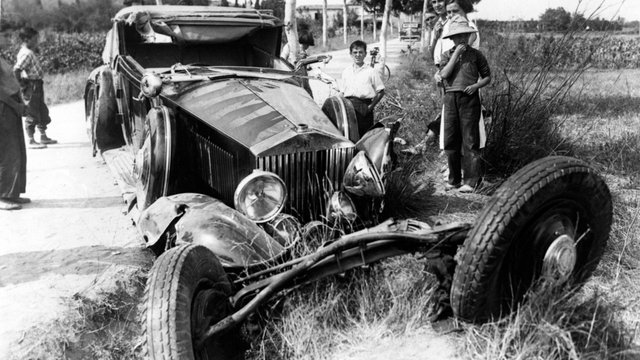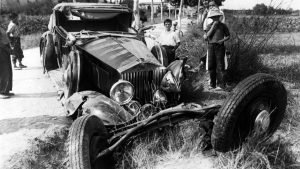
Individuals have been slamming autos for whatever length of time that autos have been near. There are a lot of various 'firsts' with regards to auto collisions that it can get a touch of confounding on the off chance that you endeavor to make sense of who the principal heedless driver was. We here at Jalopnik perceive the significance of getting the actualities straight. That is the reason we've chosen to put together a concise once-over of probably the most widely recognized 'first' auto collisions that occurred far and wide.

The wrecked car in which Prince Alexis Mdivani, the former husband of Barbara Hutton - the Woolworth Heiress, lost his life whilst driving at 90 mph in Albons, Spain on August 2, 1935. (AP Photo)
These are the occasions that helped change the idea of the vehicle. On the off chance that enough individuals are murdered or enough harm is caused, there's going to be some shock about how the hellfire we can make these perilous machines somewhat more secure. Now and again you simply need to take in the most difficult way possible.
1834: John Scott Russell's Steam Carriage Explodes in the First Act of Automotive Sabotage
We've secured this peculiar story before on Jalopnik. While Mary Ward is regularly viewed as the main casualty (we'll get to her), this mishap happened a very long time before her passing.
It's just plain obvious, in those days, autos weren't really all the burning motors or electric autos we've generally expected from nineteenth century hardware. Steam vehicles were around for a couple of decades before Karl Benz presented his auto. They looked truly out of control, yet they were basically the proto-car.
An individual named John Scott Russell threw together a steam carriage that, uh, detonated. The thing slaughtered four individuals, and he needed to close his business. Truly, his business. There was at that point an interest for a self-moved four-wheeled vehicle.
Clearly, it was supposed to be a demonstration of treachery. Some against auto protestors are thought to have heaped up a stack of metal in the street, which penetrated the steam motor and made it detonate.
1869: The "Main" Fatal Car Accident Takes out Mary Ward
Which conveys us to the casualty of researcher Mary Ward. She was out there keeping in touch with her own particular books on microscopy since no one had done as such yet. How's that for rebel?
Shockingly, her vocation was stopped, and she was destined to be associated with the odd idea of her passing. Her wonky steam engined vehicle didn't keep running over a heap of metal and detonate. Rather, they took a corner too quick, and in the period before safety belts, Ward was tossed from the auto. She kicked the bucket on affect from a broken neck.
Nobody is extremely certain why Mary Ward's demise is viewed as the primary car casualty, given the quantity of individuals who kicked the bucket in Russell's steam machine. It may very well be the deplorability of the way that such an eminent lady was murdered, one who could have been on the precarious edge of some extraordinary revelations
Whatever the case might be, individuals begun choosing that steam motors were likely not the best alternative. What's more, perhaps we should begin investigating some wellbeing gear, as well.
1891: The First Non-Fatal Crash in a Gasoline Powered Car
Ok, Ohio. We don't more often than not consider Ohio City as the home of the vehicle (we generally seek Detroit for that refinement), yet Cleveland and the encompassing territories were home to some creative personalities once upon a time.
One of those was James William Lambert. The designer assumed an immense part in the progression of early car advancement in the late nineteenth century, in charge of more than 600 licenses. Not every one of them were car in nature, but rather the person was something of a virtuoso.
In this way, it bodes well that he'd need to take his recently composed single-chamber gas auto out for a voyage to flaunt his ability to companion James Swoveland.
All things considered, completely incredible news for their great drive. Lambert hit a tree root (I'm accepting it was in the street, since I truly trust and implore that they weren't going on any rough terrain journeys as of now). The auto lost control and crushed into a hitching post for ponies.
I can't envision they were going especially quick, so Lambert and Swoveland supported just minor wounds. Not as much can be said for Lambert's pride.
1896: The First Bicycle versus Auto Showdown Takes Place in NYC
Any individual who lives in a major city has encountered no less than one side of the autos versus bikes banter. Turns out, it's one that goes the distance back to the initiation of autos.
In 1896, Henry Wells was driving a "horseless wagon" in a "horseless wagon race" (since, truly, on the off chance that it has wheels we will race it). Obviously, Wells was going so quick he lost control of the auto and began crisscrossing, the same was you do when you and someone else are strolling in inverse ways and arrive at an impasse attempting to choose who's going to be the one to move left or right.
Bicyclist Ebeling Thomas was befuddled. He had no clue where the auto should go, so he just bolted up and held up to perceive what happened.
Turns out, he got hit. Challenges!
It was definitely not a deadly mishap using any and all means. Thomas had a cracked leg, Wells got captured for rash driving, and the contention between methods for transportation started.
1899: The First Pedestrian Fatality Was at the Hands of an Electric Taxi
Electric autos were a major thing once upon a time, trust it or not. They were cleaner, calmer, and less rancid than their IC partners, disposed of the hand-wrench begin, and wiped out the need to switch gears. They were, notwithstanding, still completely equipped for causing an extremely terrible day.
Henry Bliss discovered that firsthand. There are various expressions utilized in the reports enumerating what happened. As per the Smithsonian, Bliss was "lethally harmed", "struck", "keep running over", and the casualty of a "mischance". Getting certainties straight in those days was definitely not a high need. Besides, y'know, it would look extremely awful if these modern machines were getting bludgeoned in the media for being demise machines.
This mishap set a few priorities that would prove to be useful when automakers began delivering buyer autos in the 1920s. Smith was captured and accused of homicide however not sentenced, since Bliss' demise was ruled unexpected.
source: https://jalopnik.com/the-first-car-accidents-in-the-world-explained-1828386151
Posted from my blog with SteemPress : https://www.orak11.com/index.php/2018/08/20/the-first-car-accidents-in-the-world-explained/